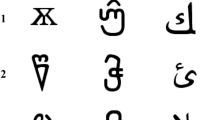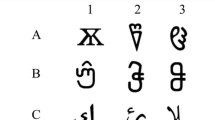Abstract
Mackay (1985) reported that subjects were able to match printed words to colors after learning to construct the color names from a pool of letters. Visual feedback from the constructed color names might have been responsible for the emergent matching to sample. In this study we prevented visual feedback during the construction procedure. Also, in matching-to-sample tests Mackaÿs subjects might simply have reached for the first letter of a comparison name, as if to begin construction, and a selection of the whole word would have been recorded. In this study, subjects constructed combinations of three arbitrary forms, with each combination composed of a different sequence of the same three forms. In the subsequent matching-to-sample test, subjects could not select a comparison on the basis of a single element because all comparisons were made up of the same elements. Even with feedback and element sequence controlled, the subjects showed nearly perfect performances in the matching-to-sample tests. These results indicated that the emergent matching-to-sample performances did not require visual feedback from the constructed stimuli and were not artifacts of the sequence of elements in the comparison stimuli.
Similar content being viewed by others
References
DUBE, W. V. (1991). Computer software for stimulus control research with Macintosh computers. Experimental Analysis of Human Behavior Bulletin, 9, 28–30.
DUBE, W. V., MCDONALD, S. J., MCILVANE, W. J., & MACKAY, H. A. (1991). Constructed-response matching to sample and spelling instruction. Journal of Applied Behavior Analysis, 24, 305–317.
GALVÄO, O. F., CALCAGNO, S., & SIDMAN, M. Testing for emergent performances in extinction. Experimental Analysis of Human Behavior Bulletin, 10, 18–20.
MACKAY, H. A. (1985). Stimulus equivalence in rudimentary reading and spelling. Analysis and Intervention in Developmental Disabilities, 5, 373–387.
MACKAY, H. A., & SIDMAN, M. (1984). Teaching new behavior via equivalence relations. In P. H. Brooks, R. Sperber, & C. McCauley (Eds.), Learning and cognition in the mentally retarded (pp. 493–513). Hillsdale, NJ: Lawrence Erlbaum Associates.
STROMER, R., & MACKAY, H. A. (1992a). Delayed constructed-response identity matching improves the spelling performance of students with mental retardation. Journal of Behavioral Education, 2, 139–156.
STROMER, R., & MACKAY, H. A. (1992b). Spelling and emergent picture-printed word relations established with delayed identity matching to complex samples. Journal of Applied Behavior Analysis, 25, 893–904.
STROMER, R., & MACKAY, H. A., & STODDARD, L. T. (1992). Classroom applications of stimulus equivalence technology. Journal of Behavior Education, 2, 225–256.
Author information
Authors and Affiliations
Additional information
This research was conducted while Olavo de Faria Galväo was a CNPQ, Brasil Postdoctoral Fellow, Grant #200398/90–3, at the New England Center for Autism. William Dube was supported in part by NICHD Grants HD 25995 and 25488. We thank Kathy Clark for help with manuscript preparation.
Rights and permissions
About this article
Cite this article
Calcagno, S., Dube, W.V., De Faria Galvão, O. et al. Emergence of Conditional Discriminations after Constructed-Response Matching-to-Sample Training. Psychol Rec 44, 509–520 (1994). https://doi.org/10.1007/BF03395141
Published:
Issue Date:
DOI: https://doi.org/10.1007/BF03395141




